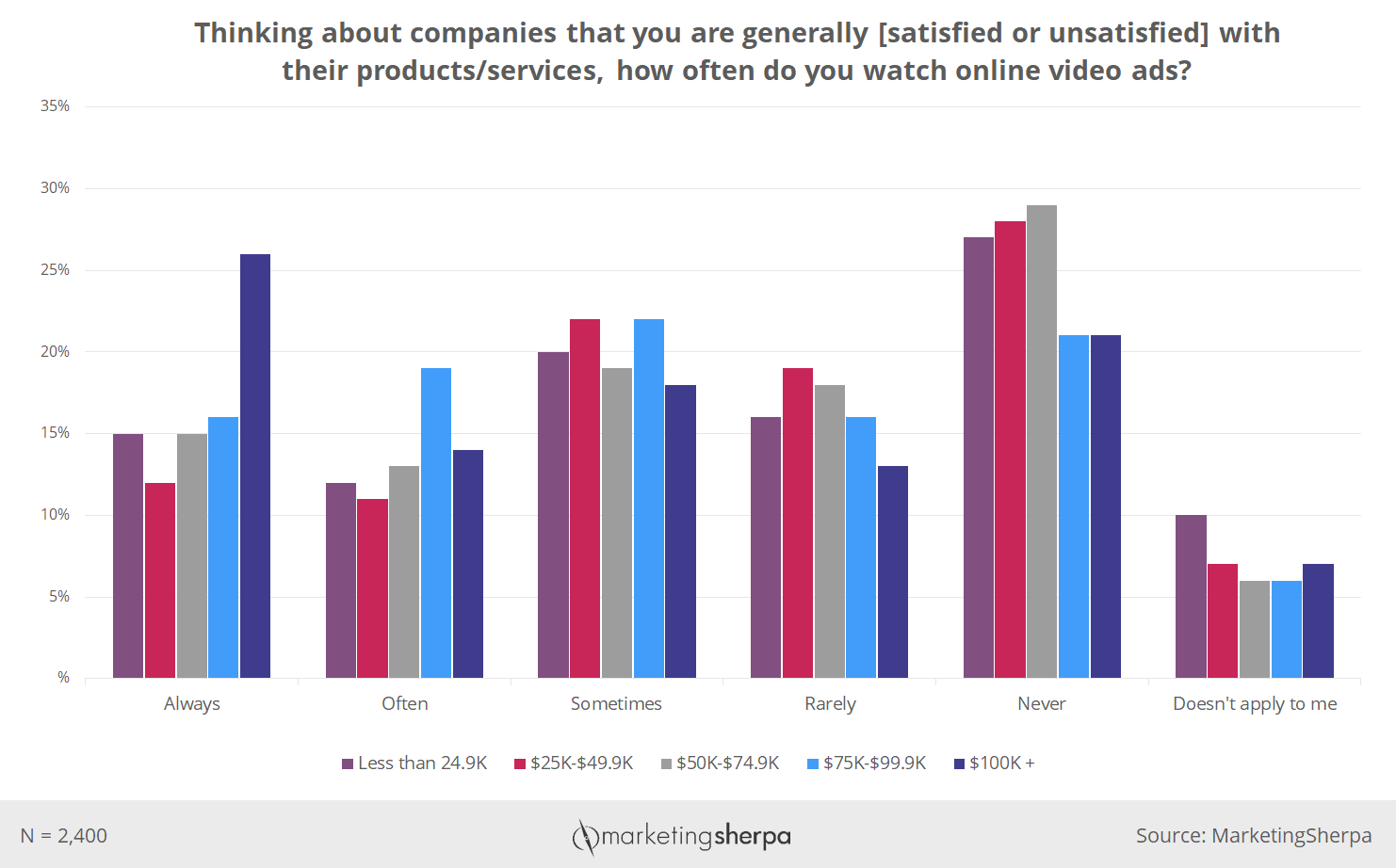
|
SUMMARY:
Affluent customers’ time is more valuable (when measured monetarily) than less affluent customers. So, you might assume they are less likely to spend that valuable time engaging with your marketing. However, we discovered the exact opposite to be true. Read on to learn from MarketingSherpa’s latest data about how likely consumers of different income levels are to engage with a range of digital and traditional marketing channels and tactics. (As seen in the MarketingSherpa Chart of the Week newsletter. Click to get a free subscription to the latest research and case studies from MarketingSherpa.) |
In October 2016, we asked 2,400 consumers: Thinking about companies that you are generally [satisfied or unsatisfied] with their products/services, how often do you do the following?
This question was followed by a list of 11 options ranging from “read print advertising in a newspaper or magazine” to “download mobile apps of these companies.”
In this article, we are not going to share the aggregate data. You can see all 11 options, along with the aggregate data, in the article “Marketing Charts: Why the value chain matters to the marketer.”
Rather, let’s explore how different demographics responded to this question — specifically by income level.
You might assume that the most affluent customers are harder to reach and the least likely to engage with marketing. After all, the time they spend engaging with marketing is more valuable based on their income level. And, as the saying goes — time is money.
However, when we broke down the data based on income level, we made a surprising discovery — the most affluent customers were the most likely to engage. Here is an example in the chart below, which shows how likely consumers are to watch online videos ads.

To see 35 charts from the study, download the free report.
Affluent consumers more likely to watch online video ads
The upper class and the upper middle class were more likely to always watch online video ads than the middle class, lower middle class, and those living below poverty level.
More than a quarter (26%) of American consumers making $100,000 per year or more always watch online video ads, while just 15% of consumers making less than $25,000 and just 12% of consumers making $25,000 to $50,000 always watch online video ads.
Also, just 21% of Americans making more than $75,000 said they never watch online video ads, while 27% of consumers making less than $25,000, 28% of consumers making $25,000 to $50,000, and 29% of consumers making $50,000 to $75,000 never watch online video ads.
Affluent consumers more likely to engage with marketing in general
This same pattern held true for 10 of the 11 channels we surveyed consumers about — Americans making $100,000 or more were more likely to read print advertising in a newspaper or magazine, sign up to get email promotions for a company’s products or services, click on online ads when they see them, and so on.
The closest thing we could find to an exception to this discovery was how often consumers listen to ads in podcasts. You can see this data in the chart below.

To see 35 charts from the study, download the free report.
In this case, more affluent customers were still more likely to engage than less affluent customers. However, consumers making more than $100,000 were just barely the second most likely to always engage with this channel — 20% of consumers making $75,000 to $100,000 always listen to ads in podcasts while 19% of consumers making more than $100,000 always listen to ads in podcasts.
This was still significantly more often than less affluent customers. Only 13% of American consumers making less than $25,000 always listen to ads in podcasts, and just 9% of consumers making $25,000 to $50,000 do the same.
Related resources
Email Automation: How an online retailer increased revenue 20%
Email Research Chart: How often customers want to receive promotional emails
Get Better Business Results With a Skillfully Applied Customer-first Marketing Strategy

The customer-first approach of MarketingSherpa’s agency services can help you build the most effective strategy to serve customers and improve results, and then implement it across every customer touchpoint.
Get More Info >MECLABS AI

Get headlines, value prop, competitive analysis, and more.
Use the AI for FREE (for now) >Marketer Vs Machine

Marketer Vs Machine: We need to train the marketer to train the machine.
Watch Now >Live, Interactive Event

Join Flint McGlaughlin for Design Your Offer on May 22nd at 1 pm ET. You’ll learn proven strategies that drive real business results.
Get Your Scholarship >Free Marketing Course

Become a Marketer-Philosopher: Create and optimize high-converting webpages (with this free online marketing course)
See Course >Project and Ideas Pitch Template

A free template to help you win approval for your proposed projects and campaigns
Get the Template >Six Quick CTA checklists

These CTA checklists are specifically designed for your team — something practical to hold up against your CTAs to help the time-pressed marketer quickly consider the customer psychology of your “asks” and how you can improve them.
Get the Checklists >Infographic: How to Create a Model of Your Customer’s Mind

You need a repeatable methodology focused on building your organization’s customer wisdom throughout your campaigns and websites. This infographic can get you started.
Get the Infographic >Infographic: 21 Psychological Elements that Power Effective Web Design

To build an effective page from scratch, you need to begin with the psychology of your customer. This infographic can get you started.
Get the Infographic >Receive the latest case studies and data on email, lead gen, and social media along with MarketingSherpa updates and promotions.